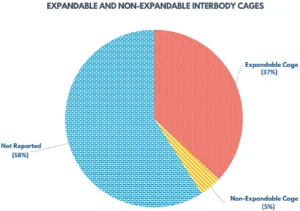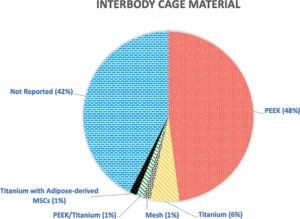In the dynamic realm of spinal surgery, the latest breakthroughs in interbody fusion with expandable cages are reshaping the landscape, ushering in a new era of precision and improved patient outcomes. Traditional spinal surgeries often face limitations in addressing a diverse range of spinal conditions. However, with the introduction of expandable cages, a significant stride has been made towards enhancing surgical techniques. These innovative cages offer a more adaptable and personalized approach to interbody fusion.

Why Expandable Cage is Designed?
In the past, interbody spinal fusion cages aimed to enhance fusion rates, restore lumbar lordosis, and address intervertebral and foraminal height. Improved containment of bone grafts was an additional benefit. Recent advancements in static interbody fusion cages prioritize applications in minimally invasive spinal surgery techniques (MISST), aiming to minimize approach morbidity, enhance insertion methods, and refine sagittal and coronal alignment control. This evolution introduced a variety of sizes and shapes for interbody fusion cages, along with technological enhancements like biomaterial components and 3-dimensional printing in manufacturing processes.
Despite progress in static cage design, challenges persisted, particularly subsidence issues linked to endplate violation during insertion, impacting clinical outcomes negatively. To address these concerns, there has been a shift from static to expandable cage technology, especially in posterior lumbar interbody fusion (PLIF) and transforaminal lumbar interbody fusion (TLIF).
The initial generation of expandable lumbar interbody fusion cages focused on vertical expansion, facilitating MISST during insertion and maximizing vertical height restoration. Subsequent generations introduced horizontal expansion, enlarging the cage footprint and covering more of the endplate. Ongoing developments concentrate on improved sagittal alignment control and the capacity to incorporate more substantial bone grafts either around the device or within an internal graft chamber.
Types of Expandable Cages
Expandable cages come in various types, each designed to address specific needs in spinal surgery. The primary types include:
Vertically Expandable Cages: These cages focus on vertical expansion, allowing surgeons to adjust the height of the cage during insertion. This type is particularly beneficial in procedures where precise height restoration is crucial, such as in posterior lumbar interbody fusion (PLIF) and transforaminal lumbar interbody spinal fusion (TLIF).
Horizontally Expandable Cages: Horizontally expandable cages offer expansion in width, providing a larger footprint to cover more of the endplate. This type aims to enhance stability and support by distributing the load more effectively across the implant and adjacent vertebrae.
Combination Expandable Cages: Some expandable cages incorporate both vertical and horizontal expansion capabilities. These combination cages offer a comprehensive solution, addressing the need for height adjustment and increased coverage simultaneously.
Angled Expandable Cages: Angled cages are designed to accommodate the natural curvature of the spine. They allow for implantation at specific angles, optimizing the alignment of the cage with the patient’s anatomy. This type is often used in procedures targeting specific regions of the spine.
Lordotic Expandable Cages: Lordotic cages are engineered to restore or enhance the natural lordosis (curvature) of the spine. They are particularly useful in addressing conditions where maintaining or correcting spinal curvature is essential for optimal outcomes.
Telescopic Expandable Cages: Telescopic cages are constructed with nested components that can be extended like a telescope. This design enables gradual expansion to the desired size, providing flexibility and precision during surgery.
Multi-Chamber Expandable Cages: Multi-chamber cages feature internal compartments that can be filled with bone graft material. This design aims to promote fusion by facilitating the incorporation of graft material into the implant, enhancing stability and promoting long-term success.
Advancement in Interbody Fusion with Expandable Cage
Embracing Minimally Invasive Precision
Traditional spinal fusion procedures often involve extensive incisions and tissue disruption. However, the introduction of expandable cages enables surgeons to embrace a minimally invasive approach. Smaller incisions result in diminished trauma to surrounding tissues, leading to reduced postoperative pain, decreased blood loss, and accelerated recovery times.
Tailored to Individual Anatomy
A notable advantage of expandable cages is their capacity for post-implantation size adjustment. This feature empowers surgeons to tailor the fit to the patient’s unique anatomy, especially beneficial in cases of anatomical variability or complex spinal conditions.
Enhancing Fusion Support
Interbody fusion’s primary objective is to foster the fusion of adjacent vertebrae, ensuring stability and pain alleviation. Expandable cages, designed for maximum contact with vertebral endplates, facilitate the fusion process, enhancing overall success and contributing to long-term spinal stability.
Restoring Spinal Alignment
Maintaining proper spinal alignment is pivotal for positive patient outcomes. Expandable cages not only provide stability but also aid in restoring normal spinal alignment, potentially reducing postoperative pain and lowering the risk of complications associated with misalignment.
Biomechanical Resonance
Advancements in materials and design focus on creating expandable cages that closely emulate the biomechanical properties of natural bone. Factors like modulus of elasticity and radiolucency aim to minimize stress shielding, ensuring the implant supports the spine while allowing for natural movement.
Mitigating Subsidence Risks
Subsidence, the sinking of the implant into the vertebral body, poses a risk to stability and fusion success. Recent designs of expandable cages aim to minimize subsidence risks by providing enhanced structural support and preventing excessive compression on the vertebral endplates.
Clinical Validation and Future Perspectives
Continual research and clinical studies assess the outcomes of patients undergoing interbody spinal fusion with expandable cages. These studies, exploring pain relief, functional improvement, and long-term fusion success, play a crucial role in validating the effectiveness of this innovative approach. As technology advances, the future promises further refinements and advancements in the field.
Expandable Cage by Zealmax Ortho
The Expandable Cage serves as a contemporary solution for vertebral body reconstruction in surgical procedures. Following vertebrae removal, the cage is inserted and expanded, ensuring excellent fixation into the vertebral endplate and providing ample space for bone graft placement.
Its specifications include a focus on a minimally invasive approach for easy insertion and quick positioning, reliable performance with dimensional accuracy, optimization of anatomical fit through an anterior cervical approach, efficient load distribution between the implant and vertebrae, continuous expansion to the desired height, stability in implant height without additional steps, and availability in Titanium Material.
With lengths ranging from 20-55 mm and various sizes and shapes, the Expandable Cage is versatile. Indicated for fusion facilitation, deformity correction, and spine stabilization and strengthening, it stands as a comprehensive solution in modern surgical practices.
Evolution of Expandable Cage
The evolution of expandable cages in spinal surgery marks a transformative journey from conventional methods to cutting-edge precision and adaptability.
Traditionally, spinal surgeries faced challenges in achieving optimal outcomes due to limitations in addressing individual patient variations. Enter the era of expandable cages – a revolutionary solution offering unprecedented control and customization.
Precision is the cornerstone of this evolution. Expandable cages empower surgeons with the ability to tailor implant sizes according to the unique anatomical nuances of each patient. This adaptability ensures a perfect fit, enhancing stability and significantly reducing the risk of complications during interbody fusion.
Conclusion
Zealmax Ortho, a leading manufacturer and exporter, specializes in cutting-edge Expandable Cages for spinal surgery. Our products emphasize a minimally invasive approach, ensuring easy insertion and reliable performance. Crafted from high-quality Titanium, available in various sizes, our expandable cages facilitate fusion, correct deformities, and contribute to spine stabilization, reinforcing Zealmax Ortho’s dedication to advancing orthopedic solutions globally.
Image Reference:Journals.Sagepage



